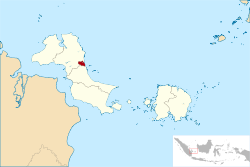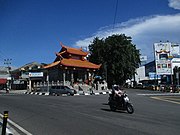
Palembang is the capital city of the Indonesian province of South Sumatra. The city proper covers 352.51 square kilometres on both banks of the Musi River in the eastern lowlands of southern Sumatra. It had a population of 1,668,848 at the 2020 Census; the official estimate as at mid 2022 was 1,729,546. Palembang is the second most populous city in Sumatra, after Medan, and the twelfth most populous city in Indonesia.

South Sumatra is a province of Indonesia, located in the southeast of the island of Sumatra. The capital and largest city of the province is the city of Palembang. The province borders the provinces of Jambi to the north, Bengkulu to the west and Lampung to the south, as well a maritime border with the Bangka Belitung Islands to the east. It is the largest province in the island of Sumatra, and it is slightly smaller than Portugal. The Bangka Strait in the east separates South Sumatra and the island of Bangka, which is part of the Bangka Belitung Islands province. The province has an area of 91,592.43 km2 (35,364 sq mi) and had a population of 8,467,432 at the 2020 Census; the official estimate as at mid-2022 was 8,657,008. The province is rich in natural resources, such as petroleum, natural gas and coal. The province is inhabited by many different ethnic groups, with Palembangese being largest ethnic group. Most speak the Palembang language, which is mutually intelligible to both Indonesian and local Palembang Malay. Other ethnic groups include the Javanese, Sundanese, Minangkabau and Chinese. Most are concentrated in urban areas and are largely immigrants from other parts of Indonesia.
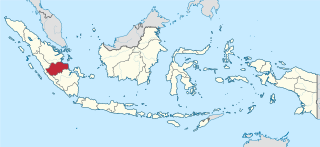
Jambi is a province of Indonesia. It is located on the east coast of central Sumatra and spans to the Barisan Mountains in the west. Its capital and largest city is also called Jambi. It is bordered by the provinces of Riau to the north, West Sumatra to the west, Bengkulu to the southwest, South Sumatra to the south, and sharing a maritime border with the Riau Islands to the east and the Pacific Ocean to the east. The province has a land area of 49,026.58 km2, and a sea area of 3,274.95 km2. It had a population of 3,092,265 according to the 2010 census and 3,548,228 according to the 2020 census; the official estimate as at mid 2022 was 3,631,136.

The Bangka Belitung Islands is a province of Indonesia. Situated off the southeastern coast of Sumatra, the province comprises two main land masses — Bangka and Belitung — and numerous smaller islands. Bangka Belitung is bordered by the Bangka Strait to the west, the Natuna Sea to the north, the Java Sea is to the south and the Karimata Strait to the east. The province's capital and largest city is Pangkalpinang. The province shares maritime borders with South Sumatra to the west, Riau Islands to the north, Banten, the Special Capital Region of Jakarta, West Java, and Central Java to the south, and West Kalimantan to the east. Bangka Belitung covers a land area of 16,690.54 km2 (6,444.25 sq mi) and had a population of 1,455,678 according to the 2020 census; the official estimate as at mid 2022 was 1,494,621.

The Riau Islands is a province of Indonesia - not to be confused with neighbouring Riau Province from which the islands were separated in 2002. The capital of the province is Tanjung Pinang and the largest city is Batam. It shares a maritime border with Riau and Jambi to the east, Bangka Belitung Islands to the south, Singapore to the northeast, Malaysia and West Kalimantan to the west, and Vietnam and Cambodia to the north.It comprises a total of 1,796 islands scattered between Sumatra, Malay Peninsula, and Borneo including the Riau Archipelago. Situated on one of the world's busiest shipping lanes along the Malacca Strait and the Natuna Sea, the province shares water borders with neighboring countries such as Singapore, Malaysia, and Brunei. The Riau Islands also have relatively large potential mineral resources and energy, as well as marine resources.

Bangka is an island lying east of Sumatra, Indonesia. It is administered under the province of the Bangka Belitung Islands, being one of its namesakes alongside the smaller island of Belitung across the Gaspar Strait. The 9th largest island in Indonesia, it had a population of 1,146,581 at the 2020 census. It is the location of the provincial capital of Pangkal Pinang, and is administratively divided into four regencies and a city. The island itself and the surrounding sea suffers considerable environmental damage from its thriving tin mining industry which operates on- and offshore.
Belitung is an island on the east coast of Sumatra, Indonesia in the Java Sea. It covers 4,800.6 km2 (1,853.5 sq mi), and had a population of 309,097 at the 2020 Census. Administratively, it forms two regencies within the province of Bangka-Belitung Islands. The island is known for its pepper and for its tin. It was in the possession of the United Kingdom from 1812 until Britain ceded control of the island to the Netherlands in the Anglo-Dutch Treaty of 1824. Its main town is Tanjung Pandan. The United Nations Educational, Scientific and Cultural Organization has declared 17 tourist attractions in the Belitung Geopark as world geoparks.

The Lingga Regency is a group of islands in Indonesia, located south of Singapore, along both sides of the equator, off the eastern coast of Riau Province on Sumatra island. They are south of the populated Riau Archipelago, known for the industrial island of Batam and the tourist-frequented island of Bintan, although the Lingga Islands themselves are rarely visited due to the infrequent local transportation. The equator goes through the northern tip of Lingga Island, the main island in the archipelago.

Tanjungpinang, also colloquially written as Tanjung Pinang, is the capital city of the Indonesian province of Riau Islands. It covers a land area of 144.56 km2, mainly on the southern Bintan Island, as well as other smaller islands such as Dompak Island and Penyengat Island. With a population of 227,663 at the 2020 Census, it is the second largest city of the province, after Batam; the official estimate as at mid 2022 was 239,854. Tanjungpinang is a historic city of the Malay culture, having served as the capital of both Johor Sultanate and Riau-Lingga Sultanate.

Sungailiat is a city and district (kecamatan) of Bangka Regency, in the Bangka-Belitung province of Indonesia. It is also the regency seat.

The Roman Catholic Diocese of Pangkal-Pinang is a diocese in the Ecclesiastical province of the metropolitan Archdiocese of Palembang on Bangka Belitung Islands in Indonesia, yet depends on the missionary Congregation for the Evangelization of Peoples.
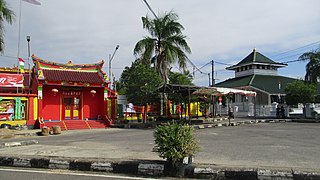
Muntok or, more commonly, Mentok is a town in the Indonesian province of Bangka-Belitung on the island of Sumatra. The capital of West Bangka Regency, it is the site of the biggest tin smelter on the world. Mentok refers to the tip of the island.

Toboali is a town in the Indonesian province of Bangka-Belitung, Indonesia. Toboali is the capital of the South Bangka Regency.

Tanjungpandan, also colloquially written as Tanjung Pandan, is the largest town on the island of Belitung in the Indonesian province of Bangka Belitung Islands, Indonesia. Tanjungpandan is the capital of the Belitung Regency comprising one of the five districts (kecamatan) within that Regency. It covers an area of 378.45 km2 and had a population of 86,487 at the 2010 Census and 103,062 at the 2020 Census.

Central Bangka Regency is a regency (kabupaten) of the Bangka Belitung Islands Province, Indonesia. It covers an area of 2,155.77 km2 and had a population of 161,075 at the 2010 Census, rising to 198,946 at the 2020 Census; the official estimate as at mid 2022 was 205,510 - comprising 106,340 males and 99,170 females. The town of Koba is its regency seat.

Belitung Regency is a regency (kabupaten) of Bangka Belitung Islands Province, Indonesia, with the town of Tanjungpandan as the regency seat. It formerly covered the whole of Belitung island, but subsequently the eastern districts on the island have been cut out to create a new East Belitung Regency. The regency now covers an area of 2,293.69 km2, and had a population of 156,765 at the 2010 Census and 182,079 at the 2020 Census; the official estimate as at mid 2022 was 186,331.
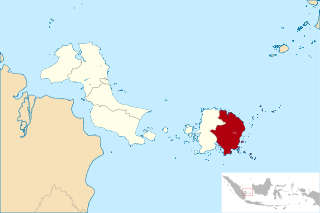
East Belitung Regency is a regency (kabupaten) of Bangka Belitung Islands Province, Indonesia, encompassing the eastern half of Belitung Island. It covers an area of 2,506.91 km2 and had a population of 106,463 at the 2010 Census and 127,018 at the 2020 Census; the official estimate as at mid 2022 was 130,463 - comprising 67,145 males and 63,318 females. Its regency seat is the town of Manggar.
Chinese Indonesians have lived in Bangka Belitung Islands, Indonesia for centuries. Bangka Belitung is one of the regions with the largest Chinese population in Indonesia besides Java, Riau, Eastern Sumatra and West Borneo.

Ibnu Saleh was an Indonesian politician, member of the Nasdem Party. Between 2016 and 2017, he was Deputy Regent of the Central Bangka Regency, and Regent from 2017 till his death in office during the COVID-19 pandemic in Indonesia.
Sungai Selan is a district (kecamatan) of Central Bangka Regency, in the Bangka-Belitung province of Indonesia.

